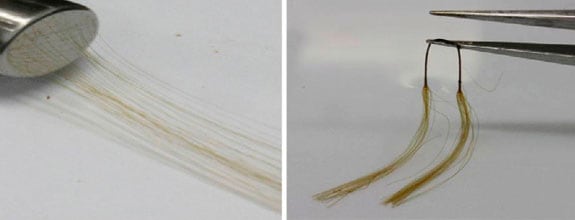
A new type of strong and flexible yarn with practical electronic properties has been made by researchers in Australia and Ireland. Spun from graphene oxide, the yarn has the highest capacitance ever seen in such graphene-based fibres. The researchers believe that the yarn could find use in “smart” textiles.
Smart textiles are those that incorporate electronic components such as displays, sensors and actuators. While still in their infancy, they could find use in a wide range of applications, from clothing that monitors the wearer’s environment for dangerous chemicals, to furnishings that alter their appearance in response to ambient light levels or changes in temperature.
In addition to being strong, flexible and lightweight, yarns and fibres used in smart textiles must have the right electronic properties. Materials with large capacitance are particularly useful because they can be used to create “supercapacitors” that store electrical energy within the textile. Although researchers have made significant progress by developing yarns from carbon nanotubes and graphene, most of these fibres are still far from ideal. In particular, the best capacitance values reported to date are about 265 F/g, which is less than half that of the theoretical maximum for graphene-based materials.
Unrivalled electrochemical capacitance
Now, Gordon Wallace of the University of Wollongong in Australia and colleagues have made yarns and fibres from graphene oxide and reduced graphene oxide that are not only highly flexible and lightweight, but that also have unrivalled values of electrochemical capacitance as high as 410 F/g.
“Our structure is a first for graphene oxide,” claims team member Seyed Hamed Aboutalebi. “Until now, 3D architectures of graphene-based capacitors were mainly limited to graphene ‘papers’ and micro-supercapacitors, which although interesting in their own right, are not really practical when it comes to making intelligent fabric.”
The researchers made their yarns using a new wet-spinning technique. This allowed them to produce unlimited lengths of highly porous yet dense, mechanically robust and flexible graphene yarns from liquid crystals of very large graphene-oxide sheets. Graphene oxide is a sheet of carbon just one atom thick that is covered with hydroxyl groups.
Supercapacitor building blocks
The researchers believe that the yarns could be used as the building blocks for supercapacitors in fully functioning smart textiles. The yarns have a Young’s modulus that is greater than 29 GPa, which makes them as strong as yarns made from natural fibres such as hemp. They also have a high electrical conductivity of about 2500 S/m and a very large surface area – about 2600 m2/g for graphene oxide and 2210 m2/g for reduced graphene oxide. In a practical two-electrode configuration, capacitance values of 410 F/g per graphene-oxide electrode can be achieved. Aboutalebi points out that this high capacitance occurs because the ions can travel fairly fast and without resistance in the fibres.
“The yarns might be ideal in powerful next-generation multifunctional renewable and wearable energy-storage systems,” he says. “Our method of making these yarns is simple and can be scaled up to produce mass quantities of the structures.”
The team, which includes researchers from Dublin City University and the University of Sydney, says that it is now busy working on making easily processed self-assembled, self-oriented and molecularly ordered graphene-based hybrids for use in intelligent fabrics.
The yarns are described in ACS Nano.
- This article first appeared on nanotechweb.org



